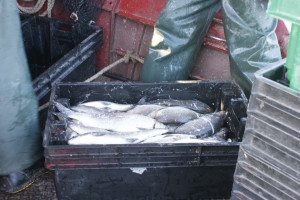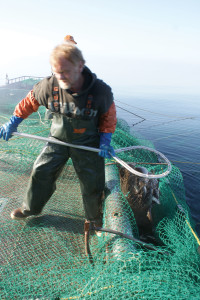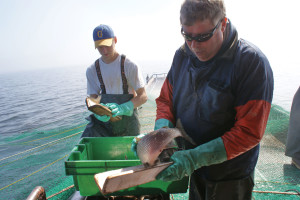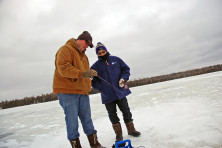In Pursuit of the Catch
- Share
- Tweet
- Pin
- Share

As The Karen rumbles out from the Henriksen Fisheries dock into Lake Michigan, the late spring sky is beginning to brighten, the air fresh, the water a mirror, but the sun is sleeping in.
“I tell my crew that tourists pay lots of money to see something like this,” Charlie Henriksen says. But the crew, one man reclining on a pile of nets and the other sitting on a gunnel, aren’t admiring scenery; they are resting, knowing that when the boat arrives at the channel bank they’ll be busy setting trap nets for whitefish.
Charlie sits at ease behind the wheel of his boat, as he has been fishing the lake since 1974. Glen “Red” Baker has crewed with him from time to time for 10 years, and  Chip Dickelman, over 20.
Chip Dickelman, over 20.
Looking Back
Charlie was 20 years old when he came to Door County from Illinois. He was helping his father renovate the Hotel Disgarden in Ellison Bay when Clayton Johnson offered him a job ice fishing.
In 1976 Charlie bought the Hotel Disgarden, operated a restaurant in it, and managed the Norrland Resort. “But I fished whenever my responsibilities at the restaurant and resort allowed me to,” he says.
He worked at various times with the Teskie, Voight and Weborg fisheries before closing the restaurant in 1980 and fishing full time. In 1989 he purchased his own boat.
“Dick Bergwin helped in starting the business,” Charlie explains, “as a crew member, and with his knowledge and ability to fix stuff. Chip Dickelman started with me in 1990 and has been a key part of the operation ever since.”
That year Charlie began renting dock space on Sand Bay in Lake Michigan. “The old Sand Bay Fishing Village has been here for over 100 years,” he says. Only one of the four original buildings survives, and the old crib dock has been replaced.
Now Charlie and partners own the property and have made improvements.
Heading North to Set Nets
Our breath steams in the morning air as The Karen continues north, past Rowleys Bay, toward Newport Park, the Northport ferry dock and Death’s Door. Charlie and his crew in their oilers, waterproof parkas and rubber boots seem timeless. Red, with his beard and weathered face, looks the archetypal fisherman. But a glance into the cabin at the GPS plotter, depth sounder, radio and radar equipment offers reminders of the present.
A skiff trails behind us, and the back deck is filled with a tangle of nets, ropes and anchors. But, as Charlie explains, everything has been carefully positioned for its systematic use.
The sky becomes more orange (weather forecasters predict storms) and a few optimistic gulls squawk overhead.
Chip cuts lengths of cord for setting trap nets as the boat shortcuts through the narrow and shallow passage of the inside cut; Charlie has to keep his eye on the depth sounder which indicates at times only 10 feet of water.
In the distance are Washington, Plum, Detroit, and Pilot Islands, and when the tug reaches Death’s Door, the sun is up and the air temperature 30 degrees. The trees along the shoreline are reflected in the mirrored stillness of the lake as Charlie studies a manila folder with columns of penciled notations recording last season’s catch.
We pass the Northport Ferry Dock for our destination, the channel bank located five miles north of Gills Rock, 10 miles from the Michigan shoreline. Once the nets are set, they will remain in place until September before being moved to Lake Michigan for the fall run.
Charlie’s navigation devices, unlike the compasses and clocks of early sailors, allow him to be precise in determining his location. When we reach our spot the crew sets to work, first untying the skiff and then setting the anchor for the lead. With Charlie at the wheel, Chip and Red feed a net from a wooden palette over the back.
“You throw this shit overboard and hope for the best!” Charlie laughs, underplaying the skill required in the process.
The configuration of a trap net is a puzzle while it is a pile of nets, anchors, ropes, and buoys. And, even installed, with every part submerged except for the warning flags, the mystery remains.
Imagine, as seen from above, the outlines of a fettered giant bird foot with a square heel pad and three long toes. The heel is tethered by rope; the toes fan before it. The tether is the king line, secured by four anchors. The heel is the box. The center toe is the lead net; the side toes are wing nets.
To envision the scale of the rig, consider that the lead net alone is 900 feet long. To appreciate the physical demands of setting a trap net, consider that each anchor tossed overboard weighs 60 pounds.
Nets, which are set at a 150 feet maximum depth, are kept in place by a series of buoys, ropes, and anchors. Whitefish swim through one of the openings between the lead and wing nets and along a tunnel that emerges into the live trap box.
The process of setting a net involves the use of a capstan (a motorized windlass) to pull submerged ropes and a skiff to navigate from one location to another. Chip pilots the skiff with the skill of a rodeo rider.
The purposes of the activities are not obvious to an observer; the crew works intuitively at their tasks with minimal communication. At times, though, Charlie becomes impatient and shouts for a correction or a faster pace.
After two hours time, both nets are set. Because Charlie and his crew will reload riggings to set two additional nets in the same location that afternoon, Red and Chip dock the skiff at Gills Rock and drive to Sand Bay; the tug will make better time without it on the 15-mile return trip. Behind us, flags on buoys serve as a warning to boaters to steer clear of the trap net.
The Karen set out at 5:30 am, and returned at 11:15 am, tasks accomplished.
The Politics of Commercial Fishing
Once commercial fishermen were governed only by compasses and the weather; times have changed.
Now, the Department of Natural Resources (DNR), sports fishermen and commercial fisheries have to arrive at a balance of interests. While they share the common goal of a sustainable fish population, they don’t always agree on their respective roles.
Early in his career Charlie became aware of the politics of commercial fishing and, at the encouragement of Jeff Weborg and Elaine Johnson, became active in the Wisconsin Commercial Fishing Association, serving as president for 21 of the last 23 years.
A major concern that faced the group was not only the equitable and sustainable sharing of resources between sports and commercial fishermen, but among fisheries themselves. The policy of Limited Entry was fully implemented as a solution in 1988.
Under this program, commercial fishermen achieve eligibility through experience and equipment. The state determines catch quotas and assigns permanent but transferable allocations to fisheries.
Because of these transferable allocations the number of fishing licenses, Charlie explains, has declined from 220 in 1988 to 51 at present, with smaller interests absorbed by those larger.
Another consideration in the politics of fishing is the presence of invasive species. Some fish, such as whitefish, by diversifying their diet and habitat, have been relatively impervious to changing environmental conditions.
“Now whitefish are found at deeper depths,” Charlie says, and because of the scarcer food supply “they take seven years to reach the legal 17-inch length,” twice as long as in the past. Other fish, such as chubs and perch, have suffered declines in population.
Zebra and quahog mussels along with alewives are well-known invasive species, and now the green slime of cladaphora algae presents problems. The DNR works to minimize the impact; Charlie has been on a government council for invasive species since 2005.
“Most of the guys who survive in fishing are willing and able to diversify,” Charlie said. “They have knowledge of business practices and the fortitude to go out there and fish every day.”
Lifting Nets
At 5:30 am the next morning the crew loads 50 crates onto the boat for the trip south to the trap nets set in Whitefish Bay. The sky is a pinkish pastel and, although the sun hasn’t risen, the lake gleams in the distance. A flock of gulls is circling overhead sensing a future meal.
Today, Charlie’s son Will joins the crew. After a semester in college, he has taken a break to fish. The Karen is named after his mom.
The tug cruises at 15 knots (18 miles per hour) pulling the skiff and, as the nets are 20 miles from the dock, the crew has time to kill. Red and Chip take smoke breaks; Chip cuts a frayed section from yellow nylon rope and splices the sound pieces together.
Will, unlike other young guys, likes getting up early. “It gives me some of the day when we get back from fishing,” he says.
The sunrise is glorious. “I have an album of sunrises on my Facebook,” he says. “Some of my friends think they are sunsets!”
Will’s involvement with the family business began early. When he and his older sister were babies, Charlie would bring them with him, fastening their car seats to the dashboard of the cabin.
 “One time I pulled into Gills Rock,” Charlie recalls, “and a tourist said, ‘It must be terrible to be out there in that rough water!’ And there was Will, about four years old, sound asleep in a corner of the cabin!”
“One time I pulled into Gills Rock,” Charlie recalls, “and a tourist said, ‘It must be terrible to be out there in that rough water!’ And there was Will, about four years old, sound asleep in a corner of the cabin!”
The Karen cruises by North Bay, Cana Island, Baileys Harbor, and Jacksonport before arriving at the four trap nets; the white dunes of Whitefish Dunes State Park rise dramatically on the distant shore.
Equally dramatic is the process of lifting a trap net.
The marker buoy is snagged with a hook and the king rope pulled over and across the deck. Capstan-winched ropes lift the box portion of the net to the surface, bunching it into a pouch of wriggling live whitefish.
Will and Red set off in the skiff to re-rig the net; earlier it had been set with spar rather than standard buoys to accommodate ice movement.
Using a long-handled dip net, Chip scoops and dumps whitefish in plastic crates. Charlie sorts fish for size and species; game fish and undersized whitefish are tossed into the lake. He uses a measuring board for fish near the 17-inch legal size. One crate is reserved for lawyers, an edible rough fish. (Ask Charlie why they are called lawyers!)
Each plastic crate holds about 100 pounds of whitefish, each one ranging from one-and-a-half to three pounds. The first catch: 525 pounds.
As he works, Charlie shouts commands to the men in the skiff: “Put the bobber on! Cut it off! Tie it on!”
The second catch: 500 pounds.
“What are we doing?” Charlie shouts, as the crew stows boxes of fish in the hold, “Fill boxes, let’s go!” He is impatient to get to the third net.
“If I don’t get 1,000 pounds on this one,” Charlie happily exclaims to me, “you’ll have to sit below with the fish! This is our best net!” The water above the net is roiling with fish bubbles. “This is a real shitload!” he continues. “This is what we have been waiting for all winter – a full net!”
The fall nets have bigger catches, 3,000 pounds or more each, but the spring harvests are smaller because fish are scattered; during summers when local demand is highest, nets may yield only 200 pounds per week.
This catch: 1,100 pounds. “You ain’t bad luck!” Chip grins at me. “If you were, we’d put you in the skiff and tow you home!”
After the fourth net, the total catch is 3,000 pounds, a respectable morning’s work.
“That didn’t take long!” Red says, having a cigarette as he and the crew set up stations on the deck to dress fish, putting out plastic boxes and buckets, dressing boards and knives. Red and Will work at one area, stunning each fish with a rap to the head before slitting and eviscerating it on the dressing board. The heads remain, in part to verify the legal lengths.
A cigarette hangs from Chip’s lips as he dresses fish, occasionally whetting his knife. He is mechanized efficiency: six seconds per fish. Charlie brags that Chip can process 1,000 pounds of fish per hour.
The work is messy business, not for the squeamish. Gulls circle overhead waiting for a gutbucket to be dumped and then descend in a white flurry.
We return to the dock by 11:00 am. The crew hoses down surfaces and puts away gear. During the afternoon, they will process the remainder of the harvest while Charlie finishes bookwork and repair projects.
The Life of a Fisherman
Will Henriksen would like to earn a degree in elementary education, but he is also thinking about the family business. “It’s nice to be on the water all the time,” he says. “It’s hard work, but you get a good night’s sleep!”
Red likes fishing because “it’s not like a factory job. You don’t know what Mother Nature will bring.”
Chip just likes being out on the water.
“I like going for the boat ride in the morning,” Charlie says. “I enjoy the challenges, figuring out where the catch is. There’s a competitive edge.
“And I enjoy the people I associate with,” he continues. “That was a big draw when I got into it. I thought they were pretty neat, and I was proud to be accepted.”
But the work is more than a cruise watching the sun come up. Bad weather can be dangerous, as can ropes and capstans. Commercial fishermen have tales of accidents, of lives lost. But ironically, Charlie notes, most accidents occur during good weather, when a fisherman’s guard is down.
Nonetheless, the lure of fishing has made it one of the world’s oldest professions. Setting out to sea on a commercial fishing boat is a primal experience, a timeless pursuit of the catch. Despite developments in technology, the industry remains as basic, as rugged, and as essential as when the first sailors navigated by stars.
Photography by Suzi Hass.


